21st Century Toys 1/32 F4U-1A Corsair
|
KIT: |
21st Century Toys 1/32 F4U-1A Corsair |
|
KIT #: |
? |
|
PRICE: |
$9.95 MSRP |
|
DECALS: |
Three options |
|
REVIEWER: |
Tom Cleaver |
|
NOTES: |
Currently out of production. |
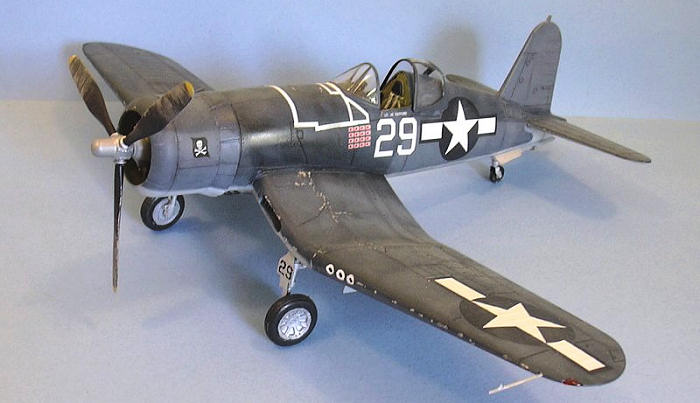
As the
airplane chosen as the Navy’s fleet defense fighter for the coming Pacific War,
the Corsair was almost a no-show.
It was not an easy airplane to fly,
and quickly earned the nicknames “Ensign Intimidator” and “Ensign Eliminator,”
which are self-explanatory. This was primarily due to the extreme length of the
nose ahead of the cockpit, which made landing difficult, coupled with a severe
tendency to bounce when brought aboard an aircraft carrier in the usual way a
young pilot might in a heavy sea with the deck rolling and yawing.
One of the
first Navy squadrons assigned to the Corsair was VF-17, which “stood up” in
January 1943, under the command of LCDR Thomas Blackburn, whose previous combat
experience was three days spent in a life raft off the coast of Casablanca after
his airplane ran out of gas on the first day of Operation Torch.
The squadron was assigned as the
fighter element of Air Group 17, which was to go aboard the new Essex-class
carrier USS Bunker Hill,
CV-17.
Bunker Hill’s
air group was also the first to take aboard the new Curtiss SB2C-1 Helldiver.
Both the Corsair and the Helldiver
needed a lot of work to become carrier-ready.
Under Blackburn’s leadership and
working closely with engineers from Vought, VF-17 discovered the secret of
“de-bouncing” the Corsair (reducing the air in the oleos), designed the stall
warning strip that became the norm on all Corsairs that followed, and
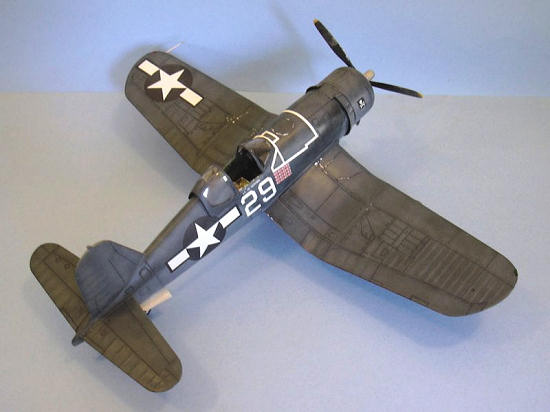 by August
1943 was ready to head into combat in the Pacific.
by August
1943 was ready to head into combat in the Pacific.
Unfortunately,
the Navy decided they didn’t want one air group operating the Corsair while all
the others were equipped with the Hellcat, which would add what was viewed as
unnecessary expense to the fleet supply system.
Thus, in September 1943, the “Jolly
Rogers” left Bunker Hill,
and were sent to the Solomon Islands, where the Marines loved the “cast off”
Corsair and were busy scything through Japanese airpower in the South Pacific.
The Jolly
Rogers reached Ondonga, on the island of New Georgia in October 1943.
They were quickly involved in the air campaign that
was aimed at invading the main Japanese base in the Solomons, the island of
Bougainville.
The invasion began on November 1,
1943, and the Jolly Rogers became the first Navy squadron to take the Corsair
into combat. On their first day of combat, VF-17 shot down six Zeroes and
damaged six other Japanese aircraft.
The squadron
demonstrated they possessed “the right stuff” on November 8, when a flight led
by Executive Officer Roger Hedrick intercepted 24 Zeroes and 15 Vals over
Empress Augusta Bay. The Vals turned and ran as soon as the Americans were
spotted.
Three Zeroes were shot down and
four damaged.
Through the teamwork Blackburn had
hammered into them during training, the outnumbered Naval Aviators came out of
the fight without loss.
The entire
Solomons campaign had the goal of defeating the Japanese bastion at Rabaul.
The Navy made two attacks on Rabaul
as part of a diversion to cover the Bougainville invasion.
The first came on November 5, when
Saratoga and
Princeton struck Rabaul.
This was followed on November 11,
1943, when Task Group 50.3, composed of the carriers
Essex,
Independence and
Bunker Hill, launched a major
strike that morning.
The carriers
were covered by Corsairs from VMF-212, VMF-221 and VF-17, the Hellcats of VF-33,
and P-40s of the RNZAF.
When it came time for the
land-based squadrons to return to New Georgia, VF-17 lowered their
recently-reinstalled tailhooks and came aboard their old home,
Bunker Hill, while VF-33 went
aboard Essex.
After refueling and rearming (while
the pilots took much-appreciated showers and had a “shipboard meal”), the
defending fighters were launched as the shipboard groups returned from their
attack on Rabaul.
A few minutes out, VF-17 sighted 65
Zeroes escorting 25 Val dive bombers and 15 Kate torpedo bombers. The Corsairs
dove into the fight with a considerable altitude advantage.
Six Zeroes went down in the first
tangle while Lt (jg) Burriss dove through the fighters and flamed a Kate.
Two Vals went down while the Kates
dodged into a nearby thunderhead.
Burriss then sighted a Betty and
shot it down.
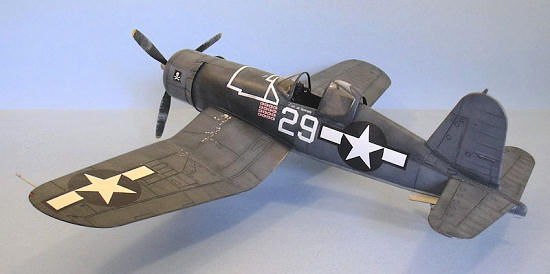 At this point,
the remaining Kates emerged from the clouds and a torpedo strike on the
Bunker Hill. They were quickly
bounced by the third division, which included Lt (jg) Ira “Ike” Kepford. The
Corsairs continued the chase as the Kates approached the fleet, which opened up
with everything it had.
Lt (jg) Hill hit a Kate and turned
away to escape the AAA; Lt (jg) Kleinmann blew up a second Kate, but was hit by
AAA, which shattered his windshield and peppered his face with broken glass. He
then limped his Corsair back to Ondonga. Ensign Gile hit a Kate after it dropped
its torpedo unsuccessfully and shot it down after a chase.
At this point,
the remaining Kates emerged from the clouds and a torpedo strike on the
Bunker Hill. They were quickly
bounced by the third division, which included Lt (jg) Ira “Ike” Kepford. The
Corsairs continued the chase as the Kates approached the fleet, which opened up
with everything it had.
Lt (jg) Hill hit a Kate and turned
away to escape the AAA; Lt (jg) Kleinmann blew up a second Kate, but was hit by
AAA, which shattered his windshield and peppered his face with broken glass. He
then limped his Corsair back to Ondonga. Ensign Gile hit a Kate after it dropped
its torpedo unsuccessfully and shot it down after a chase.
Ignoring three
Zeroes which materialized overhead, Kepford hit a Kate that was 1,000 yards from
Bunker Hill and at the point of dropping its torpedo.
Kepford opened up on the Kate,
which burst into flames and crashed into the sea before it could loose its
torpedo, as a Zero opened up on Kepford.
Fortunately a Hellcat hit the Zero,
which exploded while
Kepford dodged the AAA and climbed
to altitude, where he spotted a flight of six Vals returning to Rabaul. Zooming
up low behind them, he flamed three in succession, turning to the fourth, he
fired the last of his ammunition.
In what came to be known as The
Battle of the Solomon Sea, VF-17 was credited with 18.5 confirmed kills and 7
damaged. Two pilots were forced to ditch their planes enroute to Ondonga and
were rescued. The battle was a major strategic victory, since the Japanese gave
up all attempts to repel the Bougainville invasion.
Kepford went scoreless from
November 11 until mid-January 1944, then in swirling battles over Rabaul in what
turned out to be the last Japanese aerial resistance in the South Pacific, he
shot down 12 more Japanese aircraft to become VF-17's leading ace.
In their two combat tours, the
Jolly Rogers established an 8:1 victory record, destroying 156 planes and 5
ships for the loss of 12 pilots. During VF-17's four months of combat, 12 pilots
became aces, more than any other Navy fighter squadron in the Second World War.
This F4U-1A/D
kit by 21st
Century Toys is the third early-model Corsair to appear in 1/32, following the
venerable Revell Corsair from the early 1970s and the newer Trumpeter Corsair
released aroun d 2003.
Intere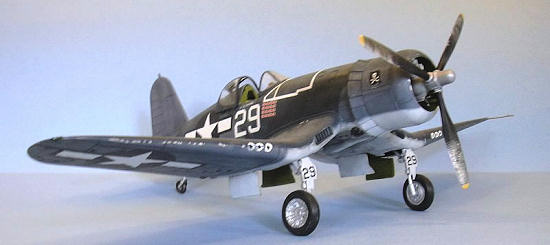 stingly, this Corsair - which
is designed as a toy - may be the most accurate of the three in overall shape,
though the other two do present more detail.
The kit was among five - the
Corsair, the Macchi 202, the Ju-87B Stuka and a Bf-109F-2/4 and Bf-109G-14 -
released in the summer of 2007 exclusively through Wal-Mart.
The Wal-Mart demographic doesn’t
appear to have many modelers, and the kits are now no longer available through
the chain.
They are, however, available every
once in awhile at hobby shops and I did see several for sale at the Nats in
Anaheim last summer, so it is likely it can also be found on dealers tables at
other shows.
At a price around $9.95 to as much
as $12.95 (probably much more on eBay now that it is no longer in production),
the kit offers excellent value that can overcome its essential toy-like nature.
With an application of
“some modeling skill required” the
kit can be turned into a very nice model.
The decals are excellent and
provide markings for three different Corsairs - two F4U-1As and an F4U-1D.
stingly, this Corsair - which
is designed as a toy - may be the most accurate of the three in overall shape,
though the other two do present more detail.
The kit was among five - the
Corsair, the Macchi 202, the Ju-87B Stuka and a Bf-109F-2/4 and Bf-109G-14 -
released in the summer of 2007 exclusively through Wal-Mart.
The Wal-Mart demographic doesn’t
appear to have many modelers, and the kits are now no longer available through
the chain.
They are, however, available every
once in awhile at hobby shops and I did see several for sale at the Nats in
Anaheim last summer, so it is likely it can also be found on dealers tables at
other shows.
At a price around $9.95 to as much
as $12.95 (probably much more on eBay now that it is no longer in production),
the kit offers excellent value that can overcome its essential toy-like nature.
With an application of
“some modeling skill required” the
kit can be turned into a very nice model.
The decals are excellent and
provide markings for three different Corsairs - two F4U-1As and an F4U-1D.
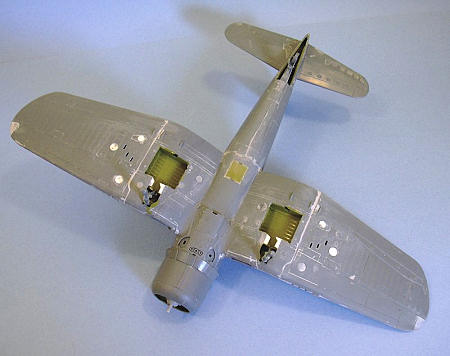 Like all the
other 21st
Century Toys models, the Corsair is more “toy” than “model,” in that it has
simple construction, and simplified parts; this is particularly true in the
landing gear, which is made so that it can be folded.
However, with an application of
“some modeling skill required,” this can be turned into a nice model of the
early Corsair without a tremendous effort.
Like all the
other 21st
Century Toys models, the Corsair is more “toy” than “model,” in that it has
simple construction, and simplified parts; this is particularly true in the
landing gear, which is made so that it can be folded.
However, with an application of
“some modeling skill required,” this can be turned into a nice model of the
early Corsair without a tremendous effort.
The first
thing I did was fill in the holes where the screws are supposed to be inserted
in the assembly.
I used the kit-supplied pieces,
filling them in with cyanoacrylate glue.
When dry, these places were sanded
smooth and then Mr. Surfacer 500 was applied over them and again sanded smooth
to get rid of all evidence of their ever being there.
I also did the same to all the
holes in the lower wing surfaces for pylons and rocket racks and such.
The wing was
assembled, and all the joints were filled in with cyanoacrylate glue and then
Mr. Surfacer 500 as described above, with panel lines rescribed where necessary.
I also made some pieces from
Evergreen sheet to give the forward area of the wheel well its correct shape.
 I intended to
use the Eduard Big Ed set for the Corsair to improve the cockpit.
This was mostly noticeable in using
the instrument panels and the seatbelts; the other items were nice, but the
model would still have looked OK without them.
I made foot guides from Evergreen
strip.
The cockpit was painted per my own
instructions in the article “Corsair 101" and the fuselage was assembled.
I used the unused gunsight from a
Trumpeter P-47.
I intended to
use the Eduard Big Ed set for the Corsair to improve the cockpit.
This was mostly noticeable in using
the instrument panels and the seatbelts; the other items were nice, but the
model would still have looked OK without them.
I made foot guides from Evergreen
strip.
The cockpit was painted per my own
instructions in the article “Corsair 101" and the fuselage was assembled.
I used the unused gunsight from a
Trumpeter P-47.
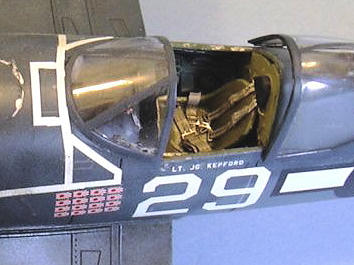 The engine is not as detailed as
say the Trumpeter R-2800s, but once it is installed in the cowling it looks good
if it has been painted and “shaded” with Tamiya “Smoke.”
The engine is not as detailed as
say the Trumpeter R-2800s, but once it is installed in the cowling it looks good
if it has been painted and “shaded” with Tamiya “Smoke.”
The wing and
the horizontal stabilizers were attached, and the joints were smoothed and the
seams filled there and on the fuselage centerline with cyanoacrylate glue and
then Mr. Surfacer 500.
When the model was completely
smooth and rescribed, I gave it a light rubdown with Tamiya polishing compound
and it was ready to go to the paint shop.
Painting:
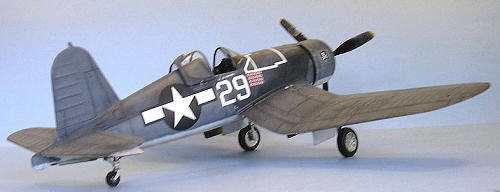 After
pre-shading the model with flat black, the tri-color paint scheme was done with
Gunze-Sangyo “Navy Blue,” “Intermediate Blue” and “White.”
Each color was then post-shaded to
varying degrees to simulate tropical sun-fading.
After
pre-shading the model with flat black, the tri-color paint scheme was done with
Gunze-Sangyo “Navy Blue,” “Intermediate Blue” and “White.”
Each color was then post-shaded to
varying degrees to simulate tropical sun-fading.
Decals:
I mostly used
the kit decals, which are excellent, other than the large “29" and the victory
flags, which came from an older Aeromaster set and are more accurate.
I used the markings information I
had discovered from my research as discussed in “Corsair 101".
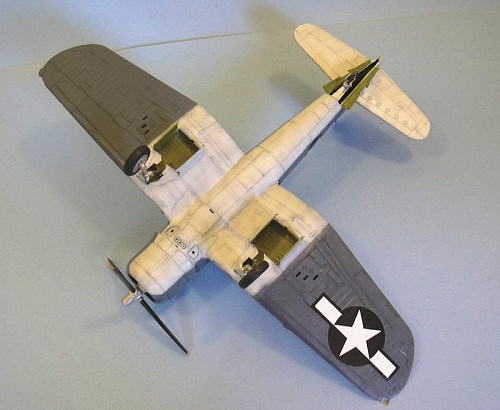 The landing
gear is not exactly right, but is “right enough” that a modeler can leave it as
is without it looking obviously inaccurate.
I used the photoetch front rear
doors from the Eduard set, since they were the right shape.
I gave the model extensive exhaust
staining on the lower fuselage and wing, with exhaust and oil staining and
gasoline-drip staining on the upper fuselage.
I “dinged” the airplane per the
well-known photos of Kepford’s airplane at the end of its career.
The canopy was unmasked and glued
in the open position.
The landing
gear is not exactly right, but is “right enough” that a modeler can leave it as
is without it looking obviously inaccurate.
I used the photoetch front rear
doors from the Eduard set, since they were the right shape.
I gave the model extensive exhaust
staining on the lower fuselage and wing, with exhaust and oil staining and
gasoline-drip staining on the upper fuselage.
I “dinged” the airplane per the
well-known photos of Kepford’s airplane at the end of its career.
The canopy was unmasked and glued
in the open position.
Out of the
box, I think this model from 21st
Century Toys makes up into a better representation of the early Corsair than
does either the Trumpeter or Revell kits with a bit of effort, even if a modeler
does not use the Eduard cockpit detail set.
The use of good seat belts is
mandatory for a good final look.
The kit is now out of production,
but well worth picking up whenever you find one.
I have a second one I will be doing
as a Fleet Air Arm Corsair in the future.
Highly recommended.
Tom Cleaver
April 2008
Review kit courtesy of my wallet.
Eduard “Big Ed” set courtesy of
Eduard.
If you would like your product reviewed fairly and quickly, please
contact
me or see other details in the
Note to
Contributors.
Back to the Main Page
Back to the Review Index Page


 by August
1943 was ready to head into combat in the Pacific.
by August
1943 was ready to head into combat in the Pacific. At this point,
the remaining Kates emerged from the clouds and a torpedo strike on the
Bunker Hill. They were quickly
bounced by the third division, which included Lt (jg) Ira “Ike” Kepford. The
Corsairs continued the chase as the Kates approached the fleet, which opened up
with everything it had.
Lt (jg) Hill hit a Kate and turned
away to escape the AAA; Lt (jg) Kleinmann blew up a second Kate, but was hit by
AAA, which shattered his windshield and peppered his face with broken glass. He
then limped his Corsair back to Ondonga. Ensign Gile hit a Kate after it dropped
its torpedo unsuccessfully and shot it down after a chase.
At this point,
the remaining Kates emerged from the clouds and a torpedo strike on the
Bunker Hill. They were quickly
bounced by the third division, which included Lt (jg) Ira “Ike” Kepford. The
Corsairs continued the chase as the Kates approached the fleet, which opened up
with everything it had.
Lt (jg) Hill hit a Kate and turned
away to escape the AAA; Lt (jg) Kleinmann blew up a second Kate, but was hit by
AAA, which shattered his windshield and peppered his face with broken glass. He
then limped his Corsair back to Ondonga. Ensign Gile hit a Kate after it dropped
its torpedo unsuccessfully and shot it down after a chase. stingly, this Corsair - which
is designed as a toy - may be the most accurate of the three in overall shape,
though the other two do present more detail.
The kit was among five - the
Corsair, the Macchi 202, the Ju-87B Stuka and a Bf-109F-2/4 and Bf-109G-14 -
released in the summer of 2007 exclusively through Wal-Mart.
The Wal-Mart demographic doesn’t
appear to have many modelers, and the kits are now no longer available through
the chain.
They are, however, available every
once in awhile at hobby shops and I did see several for sale at the Nats in
Anaheim last summer, so it is likely it can also be found on dealers tables at
other shows.
At a price around $9.95 to as much
as $12.95 (probably much more on eBay now that it is no longer in production),
the kit offers excellent value that can overcome its essential toy-like nature.
With an application of
“some modeling skill required” the
kit can be turned into a very nice model.
The decals are excellent and
provide markings for three different Corsairs - two F4U-1As and an F4U-1D.
stingly, this Corsair - which
is designed as a toy - may be the most accurate of the three in overall shape,
though the other two do present more detail.
The kit was among five - the
Corsair, the Macchi 202, the Ju-87B Stuka and a Bf-109F-2/4 and Bf-109G-14 -
released in the summer of 2007 exclusively through Wal-Mart.
The Wal-Mart demographic doesn’t
appear to have many modelers, and the kits are now no longer available through
the chain.
They are, however, available every
once in awhile at hobby shops and I did see several for sale at the Nats in
Anaheim last summer, so it is likely it can also be found on dealers tables at
other shows.
At a price around $9.95 to as much
as $12.95 (probably much more on eBay now that it is no longer in production),
the kit offers excellent value that can overcome its essential toy-like nature.
With an application of
“some modeling skill required” the
kit can be turned into a very nice model.
The decals are excellent and
provide markings for three different Corsairs - two F4U-1As and an F4U-1D.  Like all the
other 21st
Century Toys models, the Corsair is more “toy” than “model,” in that it has
simple construction, and simplified parts; this is particularly true in the
landing gear, which is made so that it can be folded.
However, with an application of
“some modeling skill required,” this can be turned into a nice model of the
early Corsair without a tremendous effort.
Like all the
other 21st
Century Toys models, the Corsair is more “toy” than “model,” in that it has
simple construction, and simplified parts; this is particularly true in the
landing gear, which is made so that it can be folded.
However, with an application of
“some modeling skill required,” this can be turned into a nice model of the
early Corsair without a tremendous effort.


